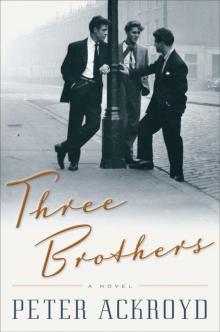- Home
- Peter Ackroyd
Venice Page 3
Venice Read online
Page 3
So they invented stories of origin, all of them involving some kind of divine dispensation—not least in the apparently “historical” fact that the Venetians were Christian exiles fleeing from pagan invaders. On the pavement of S. Maria della Salute, in Venice, is carved the inscription “unde origo inde salus” or salvation springs from origin. Thus there grew up certain exquisite and elaborate legends of the beginning. They are not to be dismissed. Legends represent the earliest form of poetry. Venice is the place of legends, particularly of religious legends, just as it has always been a city of miracles.
The people of Altino were in doubt where to flee from the pagans, until they heard a voice from the heavens declaring “Go up into the tower and look towards the stars.” When they climbed the tower, the reflections of the stars in the water made a path toward the islands of the lagoon. In another version of this story all the birds of the region were seen, with their young in their beaks, flying towards the islands. The voice out of the bright cloud, calling the exiles in their boats, has been heard at the beginning of this chapter. Eight of the earliest churches of Venice were established by divine decree. Saint Magnus was told in a vision to build a church where he first saw a flock of sheep; this was in Castello. The Virgin Mary appeared in a bright cloud, heralding the rise of S. Maria Formosa. A great assembly of birds chose the site of the church of S. Raphael. A red cloud hovered above the site of S. Salvatore near the Rialto bridge. There were other more secular legends that the Venetians had as their ancestors the Romans or even the Trojans but they, too, can be discounted. These legends, like Venice itself, have no foundation.
The city was built upon water by celestial decree. It was a miracle, in itself, to build upon the sea. Thus it became a city of miracles. It was a predestined spot, a providential site. Everywhere in the Venetian chronicles there is a great and shining image of the city. Venice became part of the history of human redemption. Its divine origin was attested by its perfect constitution, enduring for a thousand years, and even by its mercantile supremacy. In paintings by Venetian artists God the Father and the Holy Spirit preside over Saint Mark’s Square. On the Rialto bridge are carved the figures of Gabriel and the Virgin Mary at the moment of the Annunciation. Venice was idealised beyond any recalcitrant historical fact or inglorious episode.
Yet the real origins of Venice, scattered or random as they are, vouchsafe a great truth about the city. They convey certain characteristics, or certain qualities, to the nature of life there. Every organic thing wishes to give form and expression to its own nature; and so, by obscure presentiment and by the steady aggregate of communal desires, Venice took shape. The statue is latent in the marble. The Venetians had no arable land of their own, so they were obliged to earn their living by trade and industry. The city which was half land and half water devised a quintessentially “mixed” constitution in which the various forces of the state were balanced. There was a constant preoccupation, among all sections of the community, with stability and continuity. Where are those qualities more necessary than in a place shifting and uncertain? A city created by exiles became, over the centuries, a home for many and various refugees. Its empire overseas, and its incursions into mainland Italy, were all based upon the necessity for self-preservation. It always perceived itself to be a city under threat. Venice did not emerge from the union of rural peasantry. It was always urban. Venice was not, in its infancy, a feudal society. By the tenth century it was already known as “la civitas Rivoalti,” civitas implying a citizen state.
The great and enduring fact, however, was the fight against the sea. Out of this arose the need for common purpose and community of effort. There was no antagonism between the individual and the collective or, rather, the Venetian individual through the centuries subsumed himself or herself within the organism as a whole. It is an organism that, like the human organism, can be seen as a unity. It obeys its own laws of growth and change. It has an internal dynamism. It is more than the sum of its parts. Each aspect of Venetian culture and society reflects the whole.
From the ninth century three Venetian commissioners were appointed to administer and oversee the defence and reclamation of the land. An entire bureaucracy eventually emerged to control the depredations of the sea. From the beginning Venice was a state of intervention. The earliest sea-defences consisted of wooden stakes interwoven with wickerwork; at a later date rivers were diverted, and great walls of stone built against the water.
Land could not be reclaimed, nor islands joined, without the cooperation of neighbour with neighbour and community with community. Dams could not be built without the unity derived from common interest. So from the beginning Venetians were possessed by the idea of communal life. They created the first communal palace, and the first civic square, in Italy. Venice was perhaps also the first city in Europe to benefit from what has been called city-planning, with the deliberate “zoning” of industries and activities along the peripheries of the city. All this was part of the search for the common good. The battle against natural obstacles is the battle for human culture and improvement. It requires immense cohesion, and a social discipline that is best reinforced by religious observance. So emerges the concept of the state as divinely inspired.
Yet we must not discount the character and temperament of these early settlers. Their work was hard and continual, and could not have been carried on successfully without large measures of energy and optimism. These are, or were, the distinctive qualities of the Venetian people. They are, or were, proud of their city. It was one of the characteristics noted by travellers. Yet nature sometimes retaliates against those who attempt to curb it. Certain islands of the lagoon were submerged by the encroaching sea; settlements disappeared or were abandoned. There was always, somewhere in the Venetian soul, the threat of punishment and disaster.
2
Water, Water Everywhere
Venice was, until the building of a railway bridge in the middle of the nineteenth century, a small island, or collection of islands. Venetians were islanders, with all the benefits and burdens that accrue to that especial status. To be insular is to be independent; but it is also to be alone. It secures a measure of safety, but it also attracts attention from those on the larger mainland. It exemplifies vulnerability, even when outward circumstances seem favourable. Yet as an island city Venice survived all the wars and invasions that have beset Italy since the eleventh century; it successfully defied both pope and emperor, French invasion and Spanish incursion, and the continual forays of the other city-states of Italy. If it had not been surrounded by water, it would have been destroyed many centuries ago.
But that separation from the mainland, from Italy and the world, has taken its own toll. Although Venice has been part of Italy since 1866, Italy has largely ignored it. It is considered as somehow extraneous. The Italians do not really think of Venice at all; it belongs to some other realm of fancy or of artifice. On the part of the Venetians the tradition of liberty, and of freedom from the fear of invasion, bred a certain insouciance. The island guaranteed the citizens their self-sufficiency, perhaps, but it also encouraged a certain self-enclosed or self-referential attitude towards the rest of the world. It is still easy, in Venice, to grow indifferent to what is happening elsewhere. Venetians themselves are not particularly concerned with the affairs of what might be called the wider community. From the remoteness, and isolation, can also spring melancholy. Venice is no longer an island, but the island temperament remains.
And of course the islanders must always look out to sea. It is their context. It is their horizon. Where would they be without the sea? The city rests on the silt at the bottom of the sea. It is as much a part of the sea as the tides and the waves. The sea flows between the wooden piles that sustain it. The sea flushes beneath it. There is something innately unsettling about living in Venice. There is salt in the air, and the atmosphere is rendered hazy by evaporation. The haze easily becomes sea mist or sea fog. The air seems to melt above the buildings. The
salt and damp leave silvery traces on the whitened walls, as if they were made out of mother-of-pearl. The birds flying above them are the seagulls. And there is seaweed floating along the canals beside them.
So there are images of the sea throughout Venice. The floor of the basilica of Saint Mark gently undulates, as if the congregation were walking upon waves. The area of marble slabs, on the floor of the central crossing of that church, was known in the sixteenth century as il mare. The marble columns of Saint Mark’s are veined or striated like the waves. In the other churches of the city we might note the popularity of “dolphin capitals” and the motif of the shell. Ruskin described the imposing houses along the Grand Canal as “sea-palaces.” In maps of Venice, particularly those from the seventeenth and eighteenth centuries, the shape of the city is reminiscent of a fish or dolphin. The islands and sand-ridges, out of which Venice was made, seemed to the first settlers like the backs or dorsi of slumbering whales; one area of modern Venice is still called Dorsoduro or hard back. On top of one of the two presiding pillars in the piazzetta, Saint Theodore is astride a crocodile. There are crabs and dolphins on the capitals of the ducal palace. It would not be wonderful to meet a leviathan, or what in Moby-Dick Herman Melville calls “strange shapes of the unwarped primal world,” swimming at times of acqua alta in Saint Mark’s Square. It would not be wonderful to see a great polyp or medusa wallowing in the Grand Canal. It is a sea city.
The first impression of Venice may also be one of the sea. Goethe saw the sea for the first time in his life when he came to the city in the autumn of 1786; he glimpsed the Adriatic from the arched window of the campanile in Saint Mark’s Square. Ruskin arrived in Venice some fifty-five years later and, in his autobiography, he writes that “the beginning of everything was in seeing the gondola-beak come actually inside the door at [the hotel] Danieli’s, when the tide was up, and the water two feet deep at the foot of the stairs.” To find the waves of the Adriatic lapping within the city—to find the sea changing the nature of the stone buildings all around him—that was the great enchantment. The moon rules Venice. It is built on ocean shells and ocean ground; it has the aspect of infinity. It is the floating world.
The sea embodies all that is changing and variable and accidental. It is the restless and wilful element. It emerges in endless variations of colour and surface pattern. The paintings of Titian and Tintoretto have been said to manifest a “sea” of light, in which shape is fluid and ambiguous; the Venetian school of painting has been characterised as one of flowing colour rather than of form and outline, a curvilinear impulse that creates its own weight and volume. All is in flux. You glimpse the movement of the sea in Venetian statuary as well as Venetian painting. The mosaics of the city favour the depiction of the various biblical legends of the sea. Thus in the basilica of Saint Mark’s can be found “The Miraculous Draught of Fishes,” “His Walking on the Water” and “The Stilling of the Tempest.” There are certain churches that might have risen out of Neptune’s kingdom. The church of the Gesuiti, or S. Maria Assunta, has a baroque interior in which great cascades of grey and green and white marble are supposed to imitate wall hangings. But they more closely resemble waves, waves flowing and crashing down the sides of the church until arrested in a moment of silence and stillness. The floor of green marble might have furnished some cave beneath the ocean, as rays of light penetrate the marine gloom of the interior.
The rhythmic intelligence of the Venetians has informed much of the architecture of the city. The oncoming sea changes the perception of structure along the Venetian canals, where the buildings seem more delicate and attenuated. The façades of the churches undulate, weightless and unstable, against the surface of the water like shells at the bottom of a rock pool on the seashore. The architecture of Venice is horizontal in mass, like the sea. From a distance, across the lagoon, the impression of the city is of flatness along the horizon. It is perpetually in motion. It is baroque and mannerist rather than classical; it shimmers, as if seen through water; it is encrusted with ornament like a coral reef.
Venetian craftsmen were well known for their work in satin, where the gleamings and shimmerings of a particular fabric were known as “watered silk.” To work in silk was known in Venice as dar’onda all’amuer, or to make waves on the sea. There is an especial type of Venetian risotto, more liquid than elsewhere, that is known as all’onda or with waves. A sponge found in the Aegean is known as enetikos or the Venetian. In the last century you could buy in the tourist shops of Venice small ornaments made from the pearl shells found in the Lido, known as fiori di mare or the flowers of the sea. They are the only flowers indigenous to Venice.
There are other deep correlations between place and spirit. Venetian society has been described as fluid and ever-changing. Of Venetian politics Sir Henry Wotton, the English ambassador to Venice in the early seventeenth century, said that it “fluctuated, like the element of which the city was built.” That is the reason why Venetian historiographers were intent upon emphasising the continuity and stability of their society. They were always aware of the motion and restlessness of the sea within Venetian polity. At the heart of la Serenissima was a horror of transience, like the Venetian sailor’s dread of the sea. As the Venetian poet of the late sixteenth century, Veronica Franco, put it, “the sea itself yearns towards this city.” This may be considered a compliment, as long as the sea does not come too close.
It has been said also that the character of the Venetian people is like the tide, six hours up and six hours down according to the proverb. In fact there is a dialect phrase that the Venetians use to describe themselves—andara alla deriva, to be adrift. The mobility and lightness of the Venetian temperament are well known. The Venetians themselves have songs and proverbs about the sea. Coltivar el mare e lasser star la terra—cultivate the sea and leave the land to itself. There were once many popular songs that opened with the same phrase, in mezo al mar. In the middle of the sea is—what? Not familiar things. Not beautiful things. In the middle of the sea, according to the songs, are strange presentiments and terrifying apparitions. Here is a smoking chimney coming out of the waves. Here is an image of a dead lover. There is no celebration of the charm or poignancy of the sea, but rather a recital of its perils and its strangeness.
There are many legends and superstitions of the sea within popular Venetian lore. It is a shifting city, between sea and land, and thus it becomes the home for liminal fantasies of death and rebirth. According to the English traveller, Fynes Morisson, there was a statue of the Virgin in Venice which was always saluted by passing ships; it was surrounded by wax candles, burning perpetually in gratitude for her saving lives at sea. It is said that the sharp prow of the Venetian gondola was a replica of the shining blade of one of the soldier saints, Saint Theodore. On the approach of a storm Venetian sailors would take up swords and place one against the other in the shape of a cross. It was also recommended that the sailor take out a knife with a black handle and cut the air in the face of the coming storm.
Yet the sea is an intimation of impermanence. All things come from, and dissolve into, the water. It is enveloping. There is no evidence that the Venetians ever really loved the sea. It was essentially the enemy. Byron declared that the Venetians did not know how to swim and were possessed by the fear “of deep or even of shallow water.” The Venetians always prided themselves on having “dominion” over the sea, but that mastery was provisional and fearful. There was a constant fear of inundation. Of course it was the path to wealth, but the consequence was that the preponderance of their trade and power was at the mercy of the sea. The sea represented evil and chaos. It was cruel, and it was also divisive. The terror of complete submersion could also be seen in part as a nervous apprehension of divine anger. That is why there were ceremonies designed to propitiate the god or gods of the water. They may have been nominally directed towards the Christian God, but there was an element of awe and fear within the Venetian state that derived from much older creeds.
The city guarded the water, too. In the ducal palace the seat of the Magistrato alle Acque, or Master of the Waters, was adorned by an inscription stating that “The city of Venice benefiting from divine Providence was founded in water surrounded by water with water for walls. Thus, whoever might dare in whatever way to bring injury to these waters must be judged enemy of his country …” It ended with the declaration that “this law has been reckoned eternal.”
Each spring, on Ascension Day, there was a ritual that became known as “the marriage to the sea”; the spouse was the doge of Venice taking for his bride the turbulent waters. After mass in Saint Mark’s the doge and his retinue rowed into the lagoon in the doge’s own boat, the Bucintoro, followed by the nobles and guilds of the city. The doge halted at the part of the Lido where the waters of the Adriatic and the lagoon meet. The patriarch of Venice then emptied a large flask of holy water into the mingling currents. The waters of the earth and the waters of the spirit became indivisible. The Bucintoro was described by Goethe as “a true monstrance,” which means the receptacle where the holy eucharist may be displayed. So it becomes a holy grail tossing upon the waters, spreading benediction with a ritual of healing.
On the prow of the ship the doge took a marriage ring of gold and threw it into the water with the words “We espouse thee, O sea, as a sign of true and perpetual dominion.” Yet what true dominion could there be in such a union? One of the attributes of the ring is fertility, so the festival can be construed as one of the oldest of all ceremonies. It might also have been an act of supplication, designed to placate the storm-tossed and minatory sea. It could also have been a maritime version of casting the runes; there is a long tradition of rings thrown into the sea as an act of divination. All these meanings converge in this ancient rite of union with the sea, performed in spring at that place where the “inside” and the “outside” embraced. At a later date one of the punishments for heresy was death by drowning, when the condemned were rowed out to sea and despatched into the waters. These maritime executions might in turn be seen as sacrifices to the sea-gods.

 The Clerkenwell Tales
The Clerkenwell Tales The Canterbury Tales
The Canterbury Tales J. M. W. Turner
J. M. W. Turner Chatterton
Chatterton The Canterbury Tales – A Retelling
The Canterbury Tales – A Retelling Alfred Hitchcock
Alfred Hitchcock Three Brothers
Three Brothers Wilkie Collins
Wilkie Collins Venice
Venice Poe
Poe The Lambs of London
The Lambs of London London
London Queer City
Queer City Revolution, a History of England, Volume 4
Revolution, a History of England, Volume 4 Venice: Pure City
Venice: Pure City Foundation
Foundation Thames
Thames The Plato Papers
The Plato Papers The house of Doctor Dee
The house of Doctor Dee Rebellion: The History of England from James I to the Glorious Revolution
Rebellion: The History of England from James I to the Glorious Revolution Albion: The Origins of the English Imagination
Albion: The Origins of the English Imagination The Fall of Troy
The Fall of Troy The Death of King Arthur
The Death of King Arthur The Trial of Elizabeth Cree
The Trial of Elizabeth Cree London: The Biography
London: The Biography The Casebook of Victor Frankenstein
The Casebook of Victor Frankenstein Hawksmoor
Hawksmoor Charlie Chaplin
Charlie Chaplin London Under
London Under